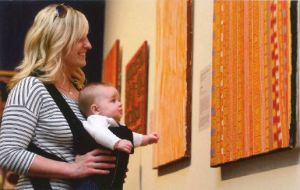
This article originally appeared in the September/October 2013 edition of the Museum magazine.
Museums are often not considered the most baby-friendly places. With look-but-don’t-touch rules and sophisticated works of art, why would a baby even be interested?
It turns out that babies are not only interested in art but have very clear preferences. Landscapes and muted paintings are out, while brightly colored contemporary art and portraits are favored. How do we know? Wiggles and squeals, outstretched little hands, big eyes focused intently- that’s how babies express aesthetic delight when they see visual images that they like. Adults who accompany the babies on our tours at the Toledo Museum of Art are awestruck at the level of engagement.
For about a year, the museum has offered monthly tours of the collection especially designed for babies 2-18 months of age and their caregivers. An observer on a recent tour noted that each of the eight participating babies was engaged and happy during the 30-minute tour and not a tear was shed. The tours have become so popular that more docents have to be trained in the neuroscience of early brain growth and development. All of this is part of the museum’s initiative to teach the skills associated with being visually literate.

It is important for docents to know about the brain and how it develops early in life because this affects visual perception and what babies can see. According to research published in 1999 by developmental psychology expert C.J. Mondloch and others, within nine minutes of birth, a newborn will turn toward a photograph of a face rather than another object. In the first month of life the rods in the eye’s retina are developed, helping babies to see black-and-white images and thus be attracted to them. The eyes send messages to the rapidly developing brain, which processes the image and triggers the reactions that can be observed.
By two months, the retinal cones are developed, which help the baby to see color. Knowing how the brain operates in tandem with vision and keeping current with the latest brain research helps docents to adequately prepare for these tours. For example, findings in my 2010 and 2011 research with babies indicate that babies like bright, bold, colorful, high-contrast images. Therefore, our tours focus on artworks that possess these characteristics. Babies like faces, so we include portraits. The selected objects for the tours change every four months to keep the tour fresh. We have babies help us select objects for the next tour series. After all, they know what they like.
During the tour, parents and their babies look at the selected works of art and parents talk with the docents about how their baby responds. Strollers are discouraged in favor of front carriers or children in their parents’ arms so they can view the works at eye level. Parents learn how to name images and describe different characteristics in a work of art in order to lay the groundwork for visual, cognitive and language development. The skills that are used to look closely at an image are the same ones that are used for reading and writing text later on in life.
As an educational institution, the Toledo Museum of Art believes it can become more relevant by teaching people how to navigate a multimedia, digital world. In using works of art to teach visual language, we help people of all ages construct meaning from what they see.
The tours are a fun and informative way to learn how to support a young child’s visual and cognitive development. A stimulating environment is important for babies whose brains are developing so rapidly. Because the Toledo Museum of Art has a long history of immersing children in the world of art, we believe that it’s never too early to start the learning process.
Kathy Danko· McGhee is director of education, Toledo Museum of Art, Ohio.








Comments